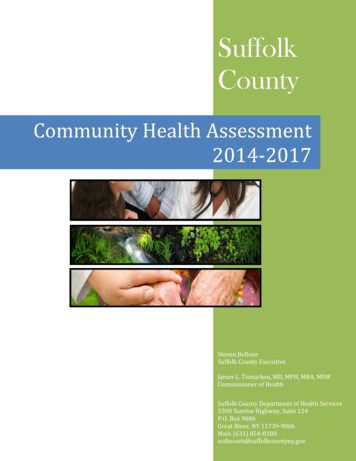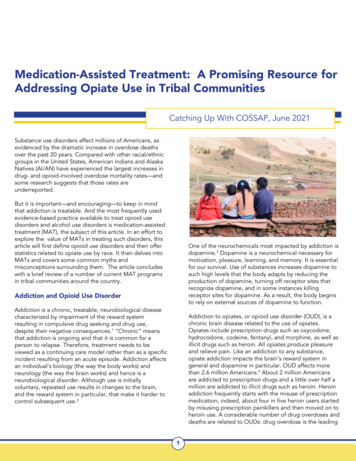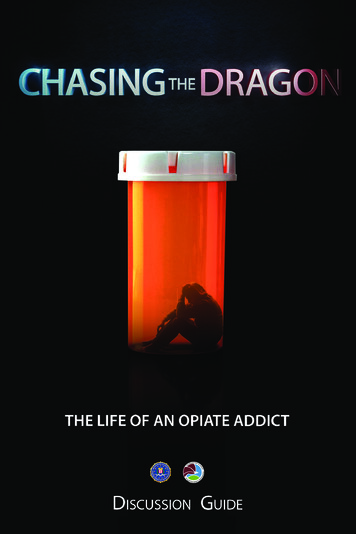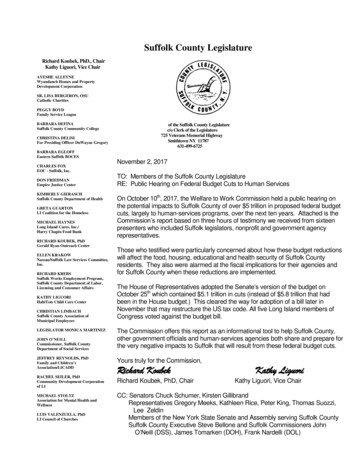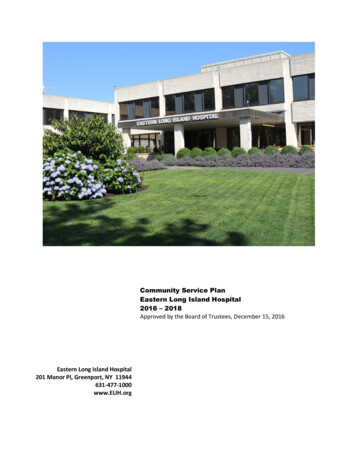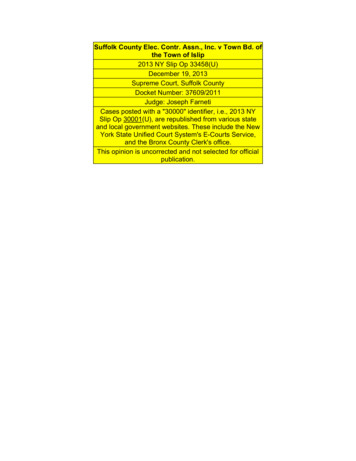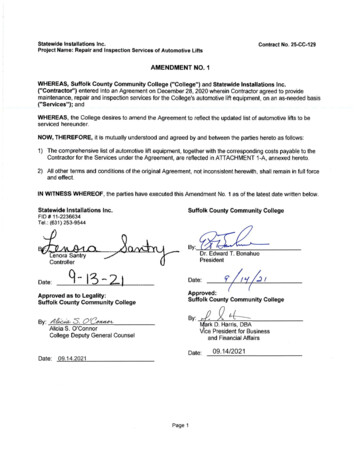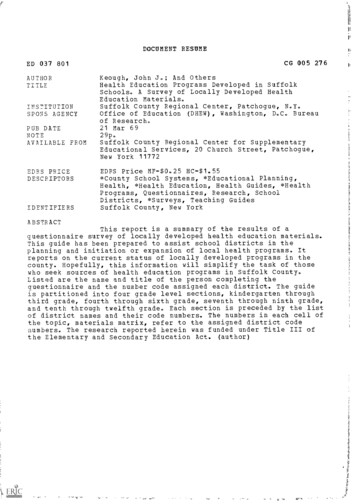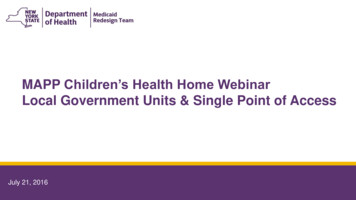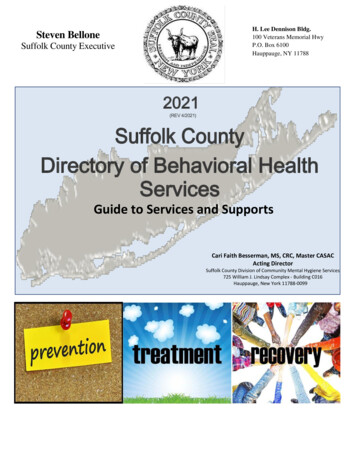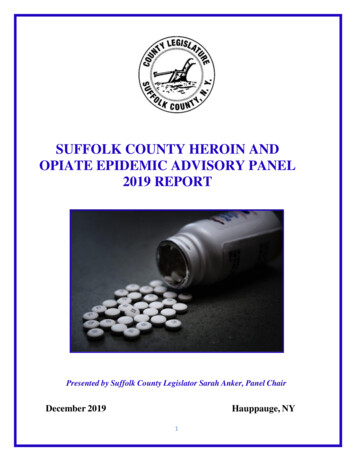
Transcription
SUFFOLK COUNTY HEROIN ANDOPIATE EPIDEMIC ADVISORY PANEL2019 REPORTPresented by Suffolk County Legislator Sarah Anker, Panel ChairDecember 2019Hauppauge, NY1
Table of ContentsMembership . 3Introduction 5Letter from the Chairwoman . .6Education and Prevention .8Treatment and Rehabilitation 12Law Enforcement and Courts Initiatives 14Legislation . . .19Conclusion and Future Goals . 24Former Recommendations . 25Panel Meetings2019 Meeting Schedule .54February 1, 2019 .55May 3, 2019 .59July 12, 2019 . .65November 15, 2019 . .70Public HearingsSeptember 25, 2019 .74October 24, 2019 .77Resources2019 Suffolk County Directory of Behavioral Health Services . 80Community of Solutions Referral List . 100Town of Huntington Opioid and Addiction Task Force Referral List . 102Suffolk County Coaches Training Program Flyer . . 103AppendixAppendix I - Original 2017 Legislation and Amendments . 104Appendix II - Glossary of Terms . 111Appendix III – Panel Letter to New York State Department of Health . 116Appendix IV – Response from New York State Department of Health . 118Appendix V – Legislature Letter to Governor Andrew Cuomo . 120Appendix VI – Update from Governor Andrew Cuomo . 122Appendix VII - Nassau County Opioid Crisis Action Plan Task Force Report . 126Appendix VIII – National Drug Control Strategy . . 1272
Annual Report from theSuffolk County Heroin and Opiate EpidemicAdvisory PanelDecember 2019 ReportPanel Membership Legislator Sarah S. Anker, acting Advisory Panel Chairwoman and designee of Presiding Officer DuWayne Gregory of the Suffolk County Legislature Legislator William Spencer, Chairman of the Health Committee of the SuffolkCounty Legislature Legislator Tom Donnelly, Chairman of the Public Safety Committee of the Suffolk CountyLegislature Legislator Samuel Gonzalez, Chairman of the Education and Human Services Committeeof the Suffolk County Legislature Suffolk County Health Department Commissioner James Tomarken, MD. Ann Marie Csorny, LCSW, Director of the Suffolk County Department of Health ServicesDivision of Community Mental Hygiene Suffolk County Police Commissioner Geraldine Hart Suffolk County Sheriff Errol D. Toulon, Jr. Suffolk County District Attorney Tim Sini Director Andrea Neubauer, Suffolk County Department of Probation Michael J. Caplan, MD., Chief Medical Examiner, Suffolk County Robert McConville, Commissioner, Selden Fire District representative for Fire Chief Council ofSuffolk County Antonette Whyte-Etere, LCSW-R, CASAC, Regional Coordinator, NYS OASAS LongIsland Regional Office3
Dr. Julie Lutz, Ph.D Chief Operating Officer for East Suffolk BOCES and panelrepresentative for the Suffolk County Superintendent’s Association Dr. Richard Rosenthal, MD., Stony Brook University Hospital Division of Psychiatry Dr. Kristie Golden, Ph.D, LMHC, CRC, Associate Director of Operations for Neurosciencesat Stony Brook University Hospital David Cohen, LCSW, Director of Outpatient Addiction Services at Eastern Long IslandHospital Janine Logan, Senior Director of Communications and Population Health, Nassau-Suffolk Hospital Council (NSHC) Dr. Patrick O’Shaughnessy, Catholic Health Services of Long Island Dr. Jeffrey Reynolds, Ph.D, CEAP, SAP, President/CEO Family and Children’s Association(FCA) Steve Chassman, LCSW, CASAC, Executive Director of Long Island Council on Alcoholismand Drug Dependence, Inc. (LICADD) Mary Silberstein, LCSW-R, CASAC, Chair of Suffolk County Communities of Solution Anthony Rizzuto LMSW, CASAC, Executive Director & Founder of Families in Support ofTreatment (FIST) Patricia Ferrandino, LCSW, CASAC, President of the Quality Consortium of Suffolk County Pamela Mizzi, MS, CASAC, LMHC, Director of Prevention at the Long Island PreventionResource Center John Venza, LCSW-R, LMHC, Director of Outreach House Michael Chiappone, LCSW, representative from Hope House Ministries Patrick Policastro, Executive Director of the North Shore Youth Council (NSYC) Veronica Finneran, member of the general public appointed by the Suffolk CountyLegislature, CN Guidance and Counseling4
IntroductionResolution 704-2017, sponsored by Suffolk County Legislator Sarah Anker, to establish a permanent Suffolk County Heroin and Opiate Epidemic Advisory Panel was approved unanimously by the Suffolk County Legislature and signed by Suffolk County Executive Steve Bellone onSeptember 25, 2017. The goal of the panel is to provide ongoing guidance and input to thecounty in combating the opiate epidemic. The panel takes an interdisciplinary approach by focusing on preventative education, enhancement of law enforcement efforts, and aiding in treatment and rehabilitation.The original Suffolk County Heroin and Opiate Epidemic Advisory Panel was formed in 2010via IR 413-2010. The panel issued a report to the Legislature outlining 48 recommendations tocombat the opioid epidemic. Several panel members met again in 2016 to update the recommendations to identify progress that had been made and where additional focus might be needed. However, no formal panel meetings occurred subsequently with the main focus of workingto implement the recommendations. The ever-evolving nature of the opiate epidemic requires acontinuous commitment to focusing on these priorities, and the newly-formed permanent panelwill continue to meet and work toward these shared goals.The panel includes members of the Legislature, representatives from Suffolk County Law Enforcement including the Police Department, Sheriff’s Department, District Attorney’s Office andthe Probation Department; Suffolk County Department of Health, Suffolk County Medical Examiner’s Office, and local rehabilitation and treatment providers, advocacy groups, hospitals,and the Suffolk County Superintendent’s Association. The panel meets quarterly and holds twopublic hearings annually. As per the resolution, a report will be filed with the Legislature in December of each year outlining the panel’s goals, recommendations, and accomplishments.Panel members – all leaders in their respective fields – brought a diverse array of experiencesand perspectives to the group, both personally and professionally. The energy, passion anddedication of each panel member was evident throughout the process. The panel has broughtcommunities and agencies together, focused the field’s collective energies and maximized thepower of collaboration.The panel’s review of 2019 initiatives that the County has implemented or continues to sponsor are detailed in this report.5
Letter from Panel Chairwoman Legislator Sarah AnkerIn 2017, I sponsored a resolution to continue Suffolk County’s focus on the opioid addiction epidemic by creating a permanent Opiate Advisory Panel. As the panel’s Chairwoman and a representative for Presiding Officer DuWayne Gregory, I work with panel members using an interdisciplinary approach by combining the knowledge of government agencies, medical professionals,law enforcement, the court system, educational institutions and advocates, to advise the countyon additional strategies to combat the epidemic.Ten years ago I was shocked to hear that one of my son’s classmates, a 13-year-old boy, died ofan opioid overdose on his living room couch. Following the boy’s death, I facilitated a presentation on drug addiction awareness by Dr. Stephen Dewey at the Mt. Sinai High School. Throughthe use of brain imaging, Dr. Dewey showed an auditorium of high school students how drugschange the chemistry of the brain and could cause permanent brain damage. This provided awake-up call for students experimenting with drugs, showing that they could actually be creatingtheir own mental illness by becoming addicted. We now know that drug addiction and mentalillness are co-occurring diseases, and in order to combat the opioid epidemic we must treat bothdiseases.The most prominent factor that contributed to the opioid epidemic was the over-prescribing ofopioid medication by doctors to their patients, including prescribing opioids to children for sportsinjuries. Two decades of patients being told to take their medications as prescribed by their doctors (who were told by the pharmaceutical companies that the drugs were safe) mushroomed intoone of this county’s most devastating drug addiction epidemics. In fact, 80% of heroin addictions began with prescription opioids.The addiction epidemic has impacted county finances, to which the county has provided additional funding for our law enforcement, health services and the Department of Social Services. Inaddition to partnering with not-for-profit organizations that provide support services, SuffolkCounty was the third municipality in the nation to sue the pharmaceutical industry, initiated byLegislator Rob Calarco. Legislator Kara Hahn chairs a committee to address the immediate carefor drug overdose patients in hospital emergency rooms and provide long-term follow-up care.Presiding Officer DuWayne Gregory launched a drug addiction services app called Stay AliveLI. Legislator William Spencer is currently facilitating the Subcommittee to Address Youth Addiction Issues. The county continues to train and distribute Naloxone, also known as Narcan , amedication that reverses the deadly effects of opioids to residents, as well as provides programsto take back unused medications (“Shed the Meds” and “Operation Medicine Cabinet”). TheNew York State I-Stop Program monitors doctors’ prescriptions, and the NYS Office of Addiction Services and Support (OASAS) provides funding and programs for prevention, treatmentand recovery.One of the most important panel initiatives is the county’s purchase of a Mass Spectrometer. Theidea was put forth at a panel meeting, and with the partnership of Suffolk County’s Police, Sheriff and District Attorney to contribute forfeiture funds, the county was able to purchase theequipment. Drug dealers are creating their own synthetic drugs by alternating the chemical com6
pounds and eluding prosecution if the drugs cannot be identified. This technology identifies themake-up of illicit drugs and assists law enforcement in identifying the drug after it has beenseized. In addition, the Medical Examiner can identify the drug that caused an overdose death.Many drug dealers are adding Fentanyl to heroin or opioids that are causing the majority of drugoverdose deaths. Fentanyl, a synthetic opioid, is 100 times more powerful than heroin. In addition, the use of the illegal drug methamphetamine is on the rise, as well as legal benzodiazepinesand Tramadol, a manmade opioid which has led to an international addiction epidemic.The epidemic fallout has caused an estimated 2 million people to become addicted to opioids inthe United States. In 2017, 47,000 Americans died of an opioid overdose - that’s 130 people perday. There have been approximately 700,000 opioid related deaths from 1999 to 2018. That’smore deaths than all American wars combined, excluding the Civil War. Even though we arecurrently seeing a deceleration of opioid addiction and death in this country, many Americansare losing their battle to addiction and we are nearing a death toll that will soon surpass wardeaths of over one million fatalities.Factors that play a role in addiction including genetics, environmental and social influences. Noteveryone’s risk is the same and researchers have identified genetic variables. In addition, timingplays a crucial role in addiction. Research in the scientific journal JAMA Psychiatry determinedthat a young person’s risk in developing addiction is increased due to the fact that their brains arestill developing and are more susceptible to at-risk behavior. That’s why it is vital we introducedrug awareness presentations at an early age, and continue with the programs throughout theirschool years, including college.As we focus on opioid addiction, let’s not lose sight of additional addictions that have negativeeffects on our society including benzodiazepines, alcohol, nicotine, caffeine, and gambling. Currently, 14.8 million people are dependent on or abuse alcohol, 59 million people are using nicotine, and 30% of teens are now vaping. As of November 21, 2019, the CDC has confirmed 47vaping related deaths and 2,290 vaping-related lung diseases. Vaping was marketed to reducecigarette smoking, but data shows the dramatic increase in youth smoking. Keep in mind: smoking substantially increases lung cancer, the most deadly cancer in the US.Suffolk County has been on the frontline fighting the war on addiction. The following report willprovide information related to the county’s efforts in combating addiction including: educationand prevention; rehabilitation and treatment; and law enforcement and the court system.I want to thank Suffolk County Presiding Officer DuWayne Gregory who has appointed me ashis representative for the panel, Suffolk County Executive Steve Bellone, and the Legislature forworking together proactively and supporting legislation and programs addressing the addictionepidemic. In addition, I graciously thank my staff and panel members for their participation aswe continue to address the challenges of the opioid epidemic, and remind everyone that by working in partnership, we can all be part of the solution to this devastating epidemic.Sarah AnkerSuffolk County LegislatorChairwoman of the Suffolk County Heroin and Opiate Epidemic Advisory Panel7
EDUCATION & PREVENTION 2019OPIOID OVERDOSE PREVENTION CLASSESIn September of this year, Suffolk County Executive Steve Bellone held training in all ten townships across Suffolk County. The training, which met the New York State Department of Healthrequirements, endeavored to teach the participants to recognize an opioid overdose, administerintranasal naloxone (Narcan ), and take additional time-dependent steps while Emergency Medical Service teams are in transit. Since the inception of Suffolk County’s Opioid Overdose Prevention Program in 2013, Suffolk County has trained 13,068 non-traditional responders, each ofwhom received a Narcan kit. In addition, local hospitals, which offer opioid overdose preventiontraining and Narcan kits under Suffolk County’s license with New York State, have dispensed1980 kits since beginning in 2016, bringing the total to 15,048.NARCAN TRAININGNarcan training and kits have also been made available across the county through civic andcommunity meetings in partnership with the Suffolk County Executive and Police Department.These programs are made possible by the Suffolk County Police Department and meet the NYSDepartment of Health requirements. There have been protocol changes including: Expansions of Naloxone from an Advanced Life Support (ALS) only medication to aBasic life Support (BLS) administered medication (2012); Increase in the minimum amount of naloxone required to be carried on ambulances operating in the system; Creation of an ALS provider to BLS provider patient transfer process for opioid overdosevictims who have been reversed with Naloxone to be transported to the emergency roomby BLS providers, allowing ALS providers to remain available for additional responsesin the jurisdiction; Leave- behind naloxone program, allowing EMS providers to provide on the spot trainingto family/friends/bystanders of opiate overdose victims on how to recognize an overdoseand administer naloxone, providing naloxone kits to the family and friends of the patientsthat are most impacted by the epidemic; and The Good Samaritan law will be printed on kits including naloxone alerting those whouse the kit that there they will not be prosecuted for criminal drug/alcohol activity therebyencouraging the use of the kits for an overdose reversal.Cost of Naloxone Increases in cost of more than 100% for particular constitutions of naloxone over past 510 years. 8) Particularly costly for the easier to utilize lay-person and BLS version ofthe medication. 800 doses of naloxone donated to Town of Babylon EMS agencies in January of 2019 by the Babylon Industrial Development Agency to reduce thefinancial burden incurred by the )8
FRESAll employees will be trained and issuing Narcan personal kits to keep with them after hours.In addition, Narcan kits will be stored in all FRES response vehicles. FRES will also be training all the coordinators and auxiliary police as well as the community emergency response teamand issuing Narcan kits.SUFFOLK COUNTY EDUCATION INITIATIVESIn response to New York State Education Law 3028 (See further details under “Legislation”) thestate has provided access to Mental Health Modules to use with students. Regional training foreducators and leaders on the implementation of this work has occurred throughout Suffolk County over the course of the 2018-2020 school years.In the Fall of 2019 a Long Island wide conference on mental health issues as prevention to substance use was held. The Long Island School Support Team (LISST) Conference was attendedby over 500 educators.Regional Professional Development has been provided to school leaders and educators acrossLong Island related to substance use and abuse, prevention, youth suicide risk assessment, restorative justice practices and general mental health issues.Narcan training has been provided to school nurses and some school mental health staff acrossSuffolk County.School Districts have partnered with the Suffolk County Police Department to provide the community education event “The Ugly Truth” to communities across Long Island.BOCES on Long Island have partnered with community providers to respond to a Request forQuestions related to a Recovery High School on Long Island. Conversations and advocacy related to the need for such a high school continue.OPIOID OVERDOSE PREVENTION PROGRAMS Multiple programs in Suffolk County and NYS administered by NYS DOH. Suffolk County DOH/EMS administers a robust program (one of the largest in the state) Trains/supports naloxone access and administration by multiple police and public safetydepartments, non-EMS fire departments. Civilian training to civic groups, businesses, social support groups, schooldistrict staff, library staff, public civilian training offered at libraries andother venues, as well as at risk populations. 500 classes and over 15,000 persons trained. The number of Narcan reversals from January to October 2019 is 387. The number of people trained from January to October 2019 is 2,010 andthe number of people trained since the inception of the program is 15,694.9
“TEST DON’T GUESS”“Test Don’t Guess” is a program available through the Suffolk County Sheriff’s office that provides free drug and alcohol testing kits to parents to monitor whether their children are using illegal substances. The testing can be done in the privacy of the home and opens the door for adiscussion between parents and their children relating to appropriate behavior and expectations.LICADD SUBSTANCE ABUSE HOTLINE: 631-979-1700The Long Island Council on Alcoholism and Drug Dependence (LICADD) in partnership withSuffolk County provides a 24/7 substance abuse hotline for individuals in crisis or who are contemplating sobriety as well as family and friends of those suffering from addiction. The hotlineconnects callers to treatment services.STAY ALIVE LIThe Stay Alive LI app, initiated by Presiding Officer DuWayne Gregory, includes informationon overdose reversal including visual guidance on the administration of the various forms of Naloxone. The app guides you through the management of a medical emergency and provides prevention and treatment resources. The app is currently available for Android and Apple products.SUFFOLK COUNTY PEER EDUCATION PILOT PROGRAMThe Suffolk County Department of Health Services Peer to Peer Substance Abuse PreventionEducation Program recognizes the value and importance of peers serving as role models and educating each other about substance-abuse prevention. This program is being piloted in localschool districts.LAW ENFORCEMENT MEDICATION TAKEBACK PROGRAMS Operation Medicine Cabinet facilitated by County Police DepartmentShed the Meds facilitated by the county Sheriff’s DepartmentSUFFOLK COUNTY COACHES TRAINING PROGRAMThe program, created by Suffolk County Legislator Kara Hahn, in partnership with LICADD and StonyBrook University, provides training for athletic coaches and highlights their unique role in thelives of their student athletes as educators, mentors, and health influencers. The trust and connection between a coach and their team creates a vital opportunity to see signs of substance use thatparents and friends might miss. This training will teach coaches: Signs and symptoms of alcohol, opiate, vaping and other substance abuse;How to talk to student athletes and parents about substance abuse;How to recognize depression and anxiety in athletes;Ways that substances like alcohol, opiates and vapes impact athletic performance;Role plays and example conversations with student athletes and parents; andHow to address injuries and other “points of risk” for addiction.10
This 75-minute training is designed to meet the unique needs of public school athletic departments. The evidence-based training provides strategies that focus on athletic performance andthe tools coaches need to see warning signs of substance abuse, talk to athletes and their parents,and make sure at-risk students get the help they need. This program is presented to school coaches, trainers and athletic directors with the help of the staff at Long Island Council on Alcoholismand Drug Dependence (LICADD).HEALing COMMUNITIES STUDYIn September 2018, the National Institutes of Health released a funding opportunity to “test theimmediate impact of implementing an integrated set of evidence-based interventions acrosshealthcare, behavioral health, justice, and other community-based settings to prevent and treatopioid misuse and Opioid Use Disorders (OUD) within highly affected communities”. Theyfunded 4 states: Kentucky, Massachusetts, New York and Ohio to work with 67 communities.The goal is to reduce opioid overdose deaths by 40% in 3 years. Suffolk County (Brookhaven) isset to be in Wave I of the study which will commence in January 2020.SUFFOLK COUNTY DIVISION OF COMMUNITY MENTAL HYGIENE SERVICESCRISIS INTERVENTION TRAINING (CIT)Crisis Intervention Training (CIT) for law enforcement officers, expanded to SuffolkCounty Police Department, Sheriff Department and Correction Officers. Funding hasbeen secured for a 2nd year and additional classes have been scheduled.TRANSPORTATIONAdvocacy efforts have included the drafting of a White Paper that outlines the numeroustransportation challenges in Suffolk County. Suffolk County Division of CommunityMental Hygiene Services provided the Conference of Local Mental Hygiene Directors(CLMHD) with a pilot program proposal to specific individuals with SUD that wouldimprove service access.PROGRAMS/SERVICESThree task groups have developed from the Medication Assisted Treatment (MAT)workgroup: Referral Lists, Learning Collaborative and Peer Services Integration. TheLearning Collaborative for MAT is ongoing. The sessions are being recorded so that individuals who are unable to participate live may have access to them at a later date. Willbe posted on county website for access. Phase II is in roll out.11
TREATMENT & REHABILITATION 2019DASH CENTER (Opened March 1, 2019) 631-952-3333The Diagnostic, Assessment and Stabilization Hub (DASH), facilitated by Suffolk CountyHealth Department, located in Hauppauge, has nurse practitioners in psychiatry, registered nurses, social workers, credentialed alcoholism and substance abuse counselors and peer specialistsavailable 24 hours a day, 7 days a week. The hotline is 631-952-3333. The center is designed toprovide on-the-spot evaluations, link people to needed long-term services and provide an alternative to hospital emergency rooms. DASH is the first crisis stabilization center in the New YorkCity metro area and the fourth statewide. As part of DASH, Family Services League began operating a decades-old, state-funded mobile crisis team. DASH Center continues to provide services to the community, including performing Medication Assisted Treatment (MAT) services.Over 100 inductions have been completed to date.https://www.youtube.com/watch?v HnSTONiRoJo&feature youtu.beSUFFOLK COUNTY EMERGENCY DEPARTMENT OPIATE RESPONSEWORKING GROUPIn 2018, Suffolk County Legislator Kara Hahn introduced Resolution 805-2018: “Directing theDevelopment of Model Opiate Overdose Protocols for Hospital Emergency Departments”. Withthe passage of this law, Legislator Hahn brought together doctors, medical professionals, the Suffolk County Health Department, and representatives from advocacy organizations to draft acomprehensive Emergency Department Opiate Response flow chart beginning with the patientbeginning admitted to the Emergency Room for an opioid overdose, and making recommendations for the best practices of care through their discharge and beyond.SHERPA PROGRAMThe SHERPA Program, offered in conjunction with Family and Children’s Association andCatholic Health Services, is a team of non-judgmental peer and family recovery coaches wellconnected with the system resources and trained to meet with substance misuse survivors andfamilies in the community. SHERPA provides support, systems navigation, and a strategy tobegin rebuilding fully, healthy lives. Services are free and include connection to treatment, harmreduction services, family and peer supports.PROJECT CONNECTProject Connect, in partnership with Suffolk County, Central Nassau Guidance and CounselingServices, Northwell Health and NYS OASAS, provides a plan of action for treatment and necessary referrals for the patients who have overdosed and are treated in the Emergency Departmentsof Southside and Huntington Hospitals. In addition, Project Connect staff continues to outreachwith the patient once they leave the hospital and meets with them at a treatment program if necessary. Since its April 2018 inception, Project Connect has seen a successful 53% engagementcompared to national average of 10%. This program has provided services to over 300 people.12
THRIVEhttp://www.thriveli.org/ or call 631-822-3396THRIVE is Transformation, Healing, Recovery, Inspiration, Validation and Empowerment.THRIVE Suffolk opened in March 2017 as Long Island’s first recovery community and outreachcenter. This free and non-clinical center opened in response to the heroin and opioid epidemicsweeping across the country. Due to the success THRIVE Suffolk and the continued need forservices and support in our communities, THRIVE Nassau was opened in June 2019.ADDICTION & COMMUNITY PSYCHIATRY PROGRAMStony Brook Medicine in collaboration with Stony Brook Eastern Long Island Hospital,launched an East End Residency Program in July 2019. This program will train physicians, specifically psychiatrists, in East End locations to help expand the workforce in our eastern mostcommunities. Their training includes addiction medicine and serves patients with these needs.OUTREACH TREATMENT CENTERhttps://opiny.org/The not for profit treatment organization Outreach organizes and hosts legislative breakfasts onLong Island which offered Legislators the opportunity to gather perspectives of treatment providers from both Nassau and Suffolk on the opioid crisis.Outreach has two (2) eligible outpatient programs certified as National Health Service Corps(NHSC) sites to provide loan repayment incentives via the federal government (Human ResourceService Administration-HRSA) to support recruitment and retention of Substance Use DisorderSUD professionals in health profession shortage areas. This loan repayment program was extended to eligible SUD providers as a response in addressing the opioid epidemic.Outreach partners with OASAS establishing workflows and quality improvement mechanisms toexpand MAT access and collaborates with AHN.RHS to enhance MAT access. Creating a centralize MAT Hub to provide medication treatment.Outreach continues community outreach efforts including presentations, testifying in hearingsbefore legislators, sharing PSA information through social media channels and has expandedNarcan Training Programs.13
LAW ENFORCEMENT 2019SUFFOLK COUNTY POLICE DEPARTMENTThe Suffolk County Police Department’s priority is to keep Suffolk County communities safeand enforce the law SCPD does this by attempting to cut off the flow of illegal drugs in the county. Drug arrests, investigations are effectuated by patrol, plain clothes and detectives. The SCPDimplements several approaches when attempting to deal with the opioid crisis in the county.These approaches often encompass multiple agencies including the SCPD, District Attorney andCourt and include:631-852-NARCCrime stoppers special phone line set up to report narcotics activity to Suffolk County CrimeStoppers. Calls are anonymous and rewards are provided under certain circumstances.PIVOT (Preventing Incarceration via Opportunities for Treatment)Referral program to attempt to get those who have overdosed into treatme
the Probation Department; Suffolk County Department of Health, Suffolk County Medical Ex-aminer’s Office, and local rehabilitation and treatment providers, advocacy groups, hospitals, and the Suffolk County Superintendent’s Association. The pane

